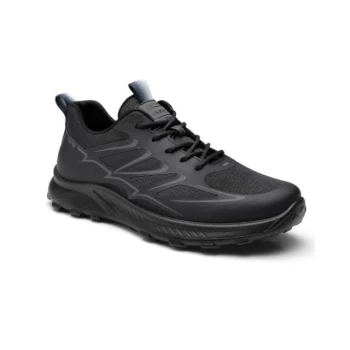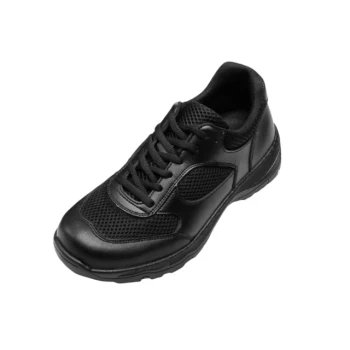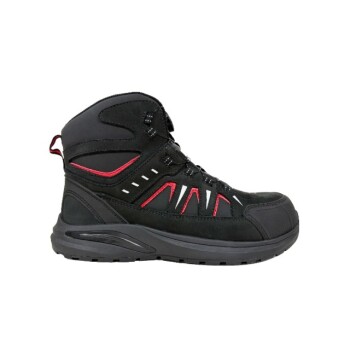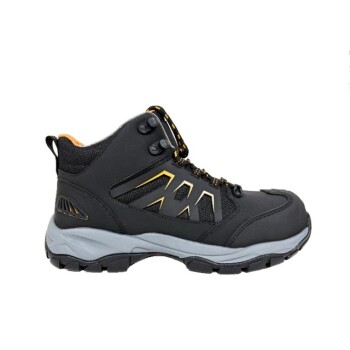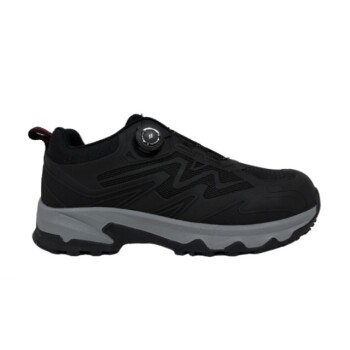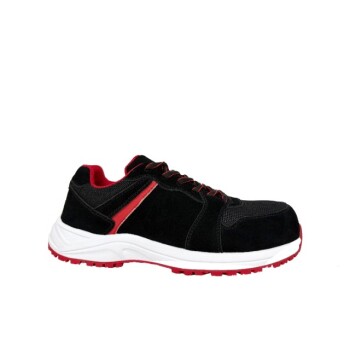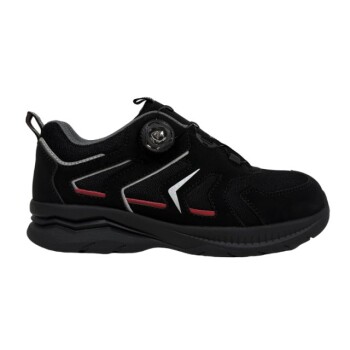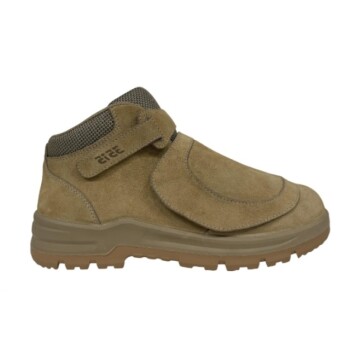Posterior Tibial Tendonitis (PTT) is an inflammation or tear of a critical tendon that supports the arch of your foot. This condition, often caused by overuse from activities like walking or standing, results from the repetitive collapse of the arch. Supportive indoor footwear directly counters this by providing an external structure that stabilizes your arch, reducing the daily strain on the tendon and allowing it to heal.
The core problem is that hard, flat indoor surfaces offer no natural support, forcing your posterior tibial tendon to work overtime with every step. The right indoor footwear acts as a portable support system for your foot, preventing arch collapse and giving this crucial tendon the rest it needs.
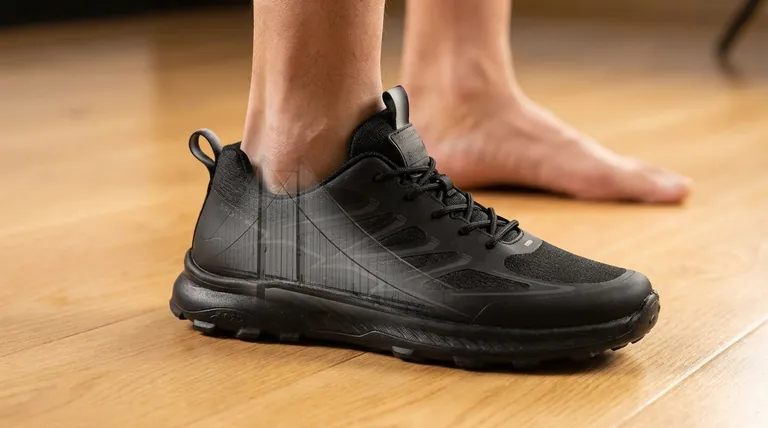
The "Why" Behind the Pain
The Suspension Bridge of Your Foot
Think of the posterior tibial tendon as the main cable on a suspension bridge. It runs down the inside of your lower leg, behind your ankle bone, and attaches to the bones on the underside of your foot. Its primary job is to hold up your arch.
When this tendon is healthy and strong, your foot functions correctly. But when it becomes overworked, it can no longer support the "bridge," leading to arch collapse, or overpronation.
How Overuse Leads to Injury
Every time you take a step, especially on an unsupportive surface, your arch naturally flattens slightly. If you have a tendency for your arch to collapse excessively, this puts a significant stretching force on the posterior tibial tendon.
Over time, this repetitive stretching causes micro-tears and inflammation in the tendon, resulting in the pain and swelling characteristic of PTT. The pain is typically felt along the inside of the ankle and foot.
Why Hard Indoor Surfaces Are a Major Factor
Most modern homes have hard, flat floors like wood, tile, or concrete. These surfaces provide zero shock absorption or natural contouring for your foot.
Walking barefoot on these surfaces for extended periods forces the structures of your foot, especially the posterior tibial tendon, to manage immense strain with every step. This makes your home a primary environment where the injury can be aggravated.
Key Features in Supportive Indoor Footwear
The Non-Negotiable: Arch Support
The single most important feature is structured arch support. A shoe with a well-defined, contoured footbed physically props up your arch from below.
This external support immediately reduces the stretching force on the tendon, providing relief and creating an environment where the inflammation can subside.
A Firm Heel Counter for Stability
A firm heel counter is the rigid cup built into the back of the shoe. Squeeze the heel of a prospective shoe; if it collapses easily, it lacks the necessary stability.
A strong heel counter prevents your heel from rolling inward, a motion that is directly linked to arch collapse and strain on the posterior tibial tendon.
A Torsionally Rigid Midsole
A shoe designed for support should not twist or bend easily in the middle. While some flexibility at the ball of the foot is needed for walking, the midsole should be firm.
This rigidity ensures the shoe acts as a stable platform, preventing the foot from collapsing through the middle and further straining the injured tendon.
Understanding the Trade-offs and Common Mistakes
Mistaking Softness for Support
Many people reach for soft, cushioned slippers or memory foam slides, believing comfort equals support. This is a critical mistake.
While these materials feel pleasant initially, they often provide zero structural support. Your foot can still collapse and pronate within the soft material, potentially making the problem worse by providing a false sense of security.
Ignoring the Progression of PTT
Posterior Tibial Tendon Dysfunction is a progressive condition. If left unmanaged, the micro-tears can become a full rupture, leading to a permanent collapse of the arch known as adult-acquired flatfoot.
Simply hoping the pain will go away while continuing to walk barefoot on hard floors is a significant risk. Consistent support is essential.
Viewing Footwear as a Complete Cure
Supportive indoor shoes are a powerful and necessary tool for managing PTT, but they are often one part of a comprehensive treatment plan.
For moderate to severe cases, a full recovery may also require rest, icing, physical therapy exercises to strengthen the tendon, or consultation with a podiatrist.
Making the Right Choice for Your Goal
By understanding your specific needs, you can select the most effective type of indoor footwear.
- If you are experiencing acute pain and inflammation: Prioritize maximum stability. Choose a dedicated recovery sandal or a supportive slipper with a pronounced, rigid arch and a deep heel cup to minimize all strain.
- If your focus is on prevention or managing mild symptoms: A good quality supportive house shoe or even a clean pair of old running shoes with good arch support will provide the necessary daily stability.
- If your pain is persistent or worsening: Use supportive footwear immediately, but it is crucial to consult a healthcare professional, such as a podiatrist or physical therapist, for an accurate diagnosis and a complete treatment strategy.
By choosing the right indoor footwear, you are actively creating a healing environment for your feet with every step you take at home.
Summary Table:
| Key Feature | Why It Helps PTT |
|---|---|
| Structured Arch Support | Props up the arch, reducing strain on the tendon. |
| Firm Heel Counter | Prevents heel rolling inward (overpronation). |
| Rigid Midsole | Provides a stable platform to stop arch collapse. |
| Avoids Soft, Unsupportive Slippers | Prevents false sense of security that can worsen injury. |
Need Durable, Supportive Footwear for Your Customers?
As a large-scale manufacturer, 3515 produces a comprehensive range of high-quality, supportive footwear perfect for distributors, brand owners, and bulk clients dealing in orthopedic or wellness products. Our production capabilities encompass all types of therapeutic shoes and boots designed with the structural features essential for managing conditions like Posterior Tibial Tendonitis.
We can help you provide effective solutions:
- Stable Arch Support Systems
- Durable, Torsionally Rigid Designs
- Customization and Bulk Order Fulfillment
Let's discuss how we can support your product line. Contact our team today to explore manufacturing opportunities.
Visual Guide

Related Products
- Custom OEM Training Shoes Wholesale Manufacturer Durable & Breathable
- Safety Footwear Wholesale Manufacturer for Custom OEM/ODM Production
- Wholesale Durable & Breathable Training Shoes for Custom Brands
- Wholesale Training Shoes with Dial Lacing System Custom OEM Manufacturing
- Wholesale Safety Footwear Manufacturer for Bulk & Custom OEM Orders
People Also Ask
- What is the purpose of cushioning in running shoes? Absorb Impact, Boost Performance
- What are the main types of reinforced toe protection for tactical boots? Choose the Right Toe for Your Mission
- What industries benefit from safety trainers? Lightweight Protection for Modern Workplaces
- Why is proper boot fastening important? Unlock Maximum Safety and Performance
- Which type of footwear is better suited for prolonged use in tough environments? Choose Durable Boots for Maximum Safety & Comfort
